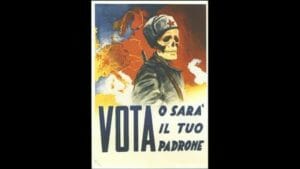The “scandal-ridden” billionaire Silvio Berlusconi — Italy’s on-and-off prime minister for an entire generation of Italians — passed on earlier this week at age 86. Most Americans know precious little about Berlusconi and his decades of impact on our world’s present and future. But that cloud of cluelessness may have lifted a bit since Berlusconi’s exit into the ever after.
Give the credit for that lifting to the obits on Berlusconi that have been multiplying across the media landscape. Berlusconi, these obits make powerfully clear, paved the political way for Donald Trump.
Born in 1936, a decade before Trump, Berlusconi had a business career that — like Trump’s — began in “property development.” Berlusconi would later become celebrated nationally, also like Trump, via his media exploits. Trump starred in a hit network TV series. Berlusconi directly owned most of Italy’s commercial TV.
Berlusconi the billionaire businessman played notoriously fast and loose with his taxes — and women. Trump followed suit. Berlusconi made himself a key player in the sports world. Trump followed suit. Both cavorted at every opportunity. Both became scandalous regulars in tabloid gossip columns.
More significantly, Berlusconi and then Trump stepped onto their national political scenes and presented themselves as champions of average people who would clean up corrupt systems and clear out the elites and the commies who had turned their nations into dysfunctional messes.
In 1994, Berlusconi would ride his raunchy private-sector record into the office of prime minister, then spend most of the next two decades losing and regaining Italy’s top political slot. Trump would win the White House in 2016 and now faces indictments at every turn. But he thinks he can regain his top-dog status. And why not? Berlusconi wiggled out of serving prison time after his 2013 conviction for tax fraud, then won election to the European Parliament in 2019 and the Italian Senate just last year.
Death has now taken out Berlusconi, but his political legacy lives on. His “disastrous economic policies,” notes the Italian sociologist Paolo Gerbaudo, undercut unions and working people and minimized taxes for Italy’s richest. His constant “celebration of extreme individualism,” meanwhile, set the stage “for Italy’s current reactionary turn.” His nation’s latest prime minister, Giorgia Meloni, descends from Italy’s post-fascist Alleanza Nazionale party.
Trump is doing his best to march the United States down the same reactionary path. His most likely GOP successor, Florida governor Ron DeSantis, is now aggressively campaigning to Trump’s political right.
The Berlusconi years, in sum, enriched the already rich and opened the door to far-right forces that hold democracy anything but dear. The Trump legacy may end up proving eerily identical.
So should we blame Italy and Berlusconi for Trump? The reverse, blaming the United States for Berlusconi, would actually make far more sense. To understand why, we need to dig into a long-forgotten history that seldom ever has received — at least in the United States — much attention.
This history begins in the wake of World War II. Italy’s two leading left parties, the Italian Communist Party and the Italian Socialist Party, entered the postwar era with widespread public support. Both parties had resisted the fascist Benito Mussolini and hastened his exit. In Italy’s 1946 Constituent Assembly elections, as the late journalist William Blum related in his 2003 book Killing Hope, these two parties “together garnered more votes and more seats” than the centrist Christian Democrats.
But the two left parties each ran candidates on their own 1946 slates and, Blum notes, ended up splitting the progressive vote. They found themselves having “to be content with some ministerial posts in a coalition cabinet under a Christian Democrat premier.” Even so, Blum adds, the hefty total vote for Italy’s two left parties “spoke plainly enough to put the fear of Marx into the Truman administration.”
That fear would turn into frenzy two years later when these same two parties announced an electoral “Popular Democratic Front” alliance for the April 1948 parliamentary elections and then, in February 1948, went on to win a key municipal election — with a vote 10 percentage points higher than their combined 1946 tally.
The Truman administration, in an unprecedented and monumental response, would quickly pull out all the stops to prevent a left victory in Italy’s upcoming April balloting. The National Security Council, notes the researcher Thomas Boghardt in a 2017 Wilson Center analysis, called on the CIA, the State Department, and U.S. military to use “all feasible means” to “minimize” the prospects of a left victory.
U.S. agencies promptly did just that. Some of those means — most notably, financial support to the Popular Democratic Front’s opposition — would be covert. The U.S. military even engaged in secret planning for helping out “the anti-Communist Italian underground” should the Front emerge victorious.
But the vast bulk of the U.S. interference in the 1948 Italian parliamentary elections would be openly obvious. By Election Day, most every Italian voter understood that the United States fervently opposed the Popular Democratic Front and would not take kindly to any victory for the left’s electoral alliance.
That message came most forcefully from an enormous letter-writing campaign that U.S. officialdom organized in the Italian-American community. Most Italian-Americans had emigrated from Italy’s desperately poor South in the two decades before World War I. They knew little about the struggles of working people in Italy’s more industrial north, even less about the anti-fascist struggles Italy’s left had led against Mussolini.
The U.S. campaign against the Front capitalized on that lack of awareness. One part of that effort, a “Committee to Aid Democracy in Italy,” had mailed into Italy some 500,000 picture postcards illustrating the horrors ahead should Italians give the nod to foreign Soviet “dictatorship.”
American newspapers, radio stations, and wealthy individuals would bankroll, in all, some 10 million pieces of mail into Italy before the election. The messages in this postal and cablegram avalanche would seldom be subtle. As one typical campaign message threatened: “If the forces of true democracy should lose in the Italian election, the American Government will not send any more money to Italy and we won’t send any more money to you, our relatives.”
“For an Italian peasant a telegram from anywhere is a wondrous thing,” the U.S. journalist Howard K. Smith reported, “and a cable from the terrestrial paradise of America is not lightly to be disregarded.”

“Vote or he will be your boss”: A sample of the U.S.-driven campaign against the left electoral alliance in Italy’s pivotal 1948 election.
The U.S. State Department would back up the themes in those letters and cables with daily short-wave broadcasts. In one, the famed William Donovan, the head of the war-time precursor to the CIA, warned that a left victory in the 1948 elections would end in a “communist dictatorship” that would have Italy’s industrial plants “dismantled and shipped to Russia” and millions of Italian workers “deported to Russia for forced labor.”
Even Frank Sinatra got into the act, joining with a host of other show-biz stars in a series of radio programs, William Blum writes, “designed to win friends and influence the vote in Italy.”
The Soviets, Blum adds, made “a few feeble gestures for a while” to aid the Italian left — releasing, for instance, some Italian war prisoners — but Soviet officials had by 1948 actually become “apprehensive of what the American and British reaction to a Communist victory at the polls might be.”
The end result of the public relations blitz against Italy’s Popular Front? A stunning victory for the Christian Democrats. The party took nearly half the total vote, 48 percent, to the left’s meager 31 percent and would go on to dominate the Italian political agenda for over a generation, finally collapsing early in 1994 amid a massive kickback scandal that involved over half of Italy’s parliament.
On hand to pick up the political pieces: a man who positioned himself as obviously much too rich to be bribed, Italy’s self-proclaimed savior, Silvio Berlusconi. He would become, observes the European historian Philipp Ther, “the first right-wing populist to govern a developed western industrial country.”
This billionaire’s legacy? Two-thirds of all Italians between the ages of 18 and 34 are now living at home with their parents because Italy’s “miserable starting salaries,” explains Ther, “mean that young Italians generally cannot afford their own place.” No single stat may better demonstrate “how the first right-wing populist to govern a large western industrialized nation drove his country into the ground.”
Sam Pizzigati co-edits Inequality.org. His latest books include The Case for a Maximum Wage and The Rich Don’t Always Win: The Forgotten Triumph over Plutocracy that Created the American Middle Class, 1900-1970. Twitter: @Too_Much_Online.
Inequality.org has been tracking inequality-related news and views for nearly two decades. A project of the Institute for Policy Studies since 2011, our site aims to provide information and insights for readers ranging from educators and journalists to activists and policy makers.
If you would like to support and help expand our work, please consider making a donation. Thank you! DONATE


Spread the word